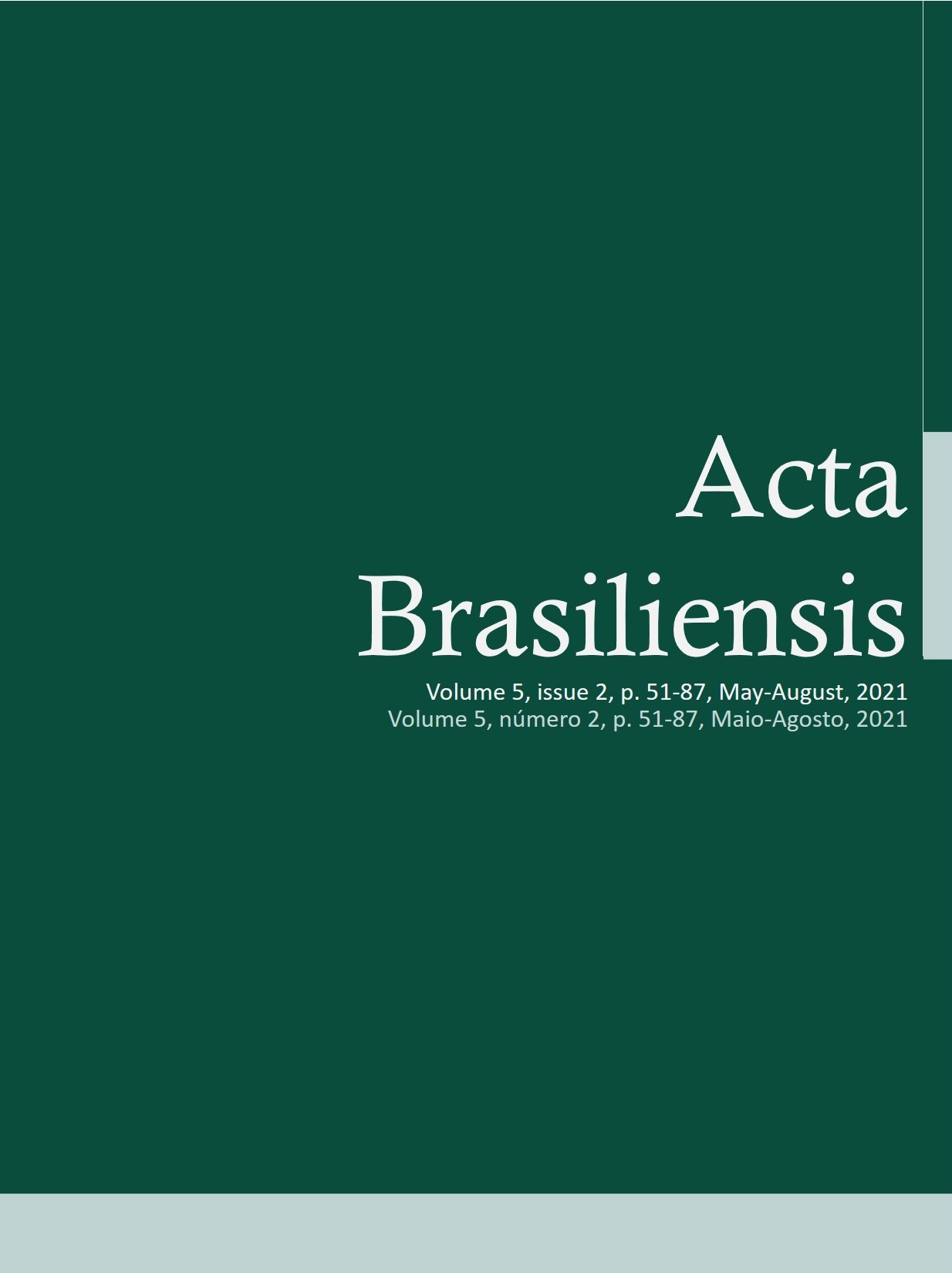Características biológicas de Trichogramma pretiosum Riley, 1879 (Hymenoptera: Trichogrammatidae) sob estresse de temperatura por gerações sucessivas
DOI:
https://doi.org/10.22571/2526-4338484Palavras-chave:
aclimatação, controle biológico, fatores climáticos, parasitoide de ovoResumo
O objetivo deste estudo foi avaliar as características biológicas de Trichogramma pretiosum (Riley 1879) submetido a temperatura ambiente e estresse térmico por sucessivas gerações. A avaliação foi realizada em parcelas subdividida no tempo. A Temperatura (25 ºC – temperatura Ambiente e 33 ºC – estresse térmico) foi o Fator 1 e as gerações (n = 15) foram o Fator 2. As características biológicas avaliadas foram: longevidade; comprimento da tíbia posterior; número de ovos parasitados; emergência; período ovo-adulto; razão sexual e indivíduos deformados. O aumento da temperatura, provocou, desde as primeiras gerações de T pretiosum, influência em todas as variáveis observadas. Entretanto, para as variáveis emergência e a razão sexual, não houve diferença significativa entre o stress térmico e o controle (temperatura ambiente) a partir da 14 geração , o que sugere-se uma adaptalibidade da espécie. Esssa adaptabilidade podem implicar na obtenção de inimigos naturais mais agressivos em relação ao seu hospedeiro (inseto praga) e consequentemente na maior eficiência do controle biológico.
Downloads
Referências
Owen, W.R., & Stern, V.M. (1966). Effect of temperature on the production of males and sexual mosaics in a uniparental race of Trichogramma semifumatum (Hymenoptera: Trichogrammatidae). Annals of the Entomological Society of America, 59(4), 823-834. doi: 10.1093/aesa/59.4.823
Bueno, R.C.O.F., Parra, J.R.P., & de Freitas ueno, A. (2012). Trichogramma pretiosum parasitism of Pseudoplusia includens and Anticarsia gemmatalis eggs at different temperatures. iological Control, 60(2), 154-162. doi: 10.1016/j.biocontrol.2011.11.005
Carvalho, G.D.S., Silva, L.., Reis, S.S., Veras, M.S., Carneiro, E., Almeida, M.L.D.S., & Lopes, G.N. (2017). iological parameters and thermal requirements of Trichogramma pretiosum reared on Helicoverpa armigera eggs. Pesquisa agropecuária brasileira, 52(11), 961-968. doi: 10.1590/s0100-204x2017001100001
De Bach, P. (1964). iological control of insect pests and weeds. iological control of insect pests and weeds.
Kazmer, D.J., & Luck, R.F. (1995). Field tests of the size‐fitness hypothesis in the egg parasitoid Trichogramma pretiosum. Ecology, 76(2), 412-425. doi: 10.2307/1941200
Kingsolver, J.G., & Huey, R.. (2008). Size, temperature, and fitness: three rules. Evolutionary Ecology Research, 10(2), 251-268.
Milanez, A.M., Carvalho, J.R.D., Lima, V.L.S., & Pratissoli, D. (2018). Functional response of Trichogramma pretiosum on Trichoplusia ni eggs at different temperatures and egg densities. Pesquisa Agropecuária rasileira, 53(5), 641-645. doi: 0100-204x2018000500013
Moyes, C., & Schulte, P. (2010). Sistemas Respiratórios. Princípios de Fisiologia Animal 2ªed. Porto Alegre: Artmed, 412-467.
Nielsen, M.E., & Papaj, D.R. (2015). Effects of developmental change in body size on ectotherm body temperature and behavioral thermoregulation: caterpillars in a heat-stressed environment. Oecologia, 177(1), 171-179. doi: 10.1007/s00442-014-3123-3
Oliveira, C.M., Oliveira, J.V., Breda, M.O., França, S.M., & Duarte, .L.R. (2017). iological parameters and thermal requirements of Trichogramma pretiosum for the management of the tomato fruit borer (Lepidoptera: Crambidae) in tomatoes. Crop Protection, 99, 39-44. doi: 10.1016/j.cropro.2017.04.005
Pratissoli, D., Fornazier, M.J., Holtz, A.M., Gonçalves, J.R., Chioramital, A.., & Zago, H.. (2003). Ocorrência de Trichogramma pretiosum em áreas comerciais de tomate, no Espírito Santo, em regiões de diferentes altitudes. Horticultura rasileira, 21(1), 73-76. doi: 10.1590/S0102-05362003000100015
Querino, R.., Mendes, J.V., Costa, V.A., & Zucchi, R.A. (2017). New species, notes and new records of Trichogramma (Hymenoptera: Trichogrammatidae) in razil. Zootaxa, 4232(1), 137-143. doi: 10.11646/zootaxa.4232.1.11
R development core team (2019). R: A language and environment for statistical computing, R Foundation for Statistical Computing, Vienna. Available in: https://www.R-project.org/
Van den osch, R., Messenger, P.S., & Gutierrez, A.P (1982). An Introduction to biological control. Plenum Press, New York.
Wu, L.H., Hoffmann, A.A., & Thomson, L.J. (2016). Potential impact of climate change on parasitism efficiency of egg parasitoids: a meta-analysis of Trichogramma under variable climate conditions. Agriculture, Ecosystems & Environment, 231, 143-155. doi: 10.1016/j.agee.2016.06.028
Zuo, W., Moses, M.E., West, G.., Hou, C., & rown, J.H. (2012). A general model for effects of temperature on ectotherm ontogenetic growth and development. Proceedings of the Royal Society : iological Sciences, 279(1734), 1840-1846. doi: 10.1098/rspb.2011.2000


